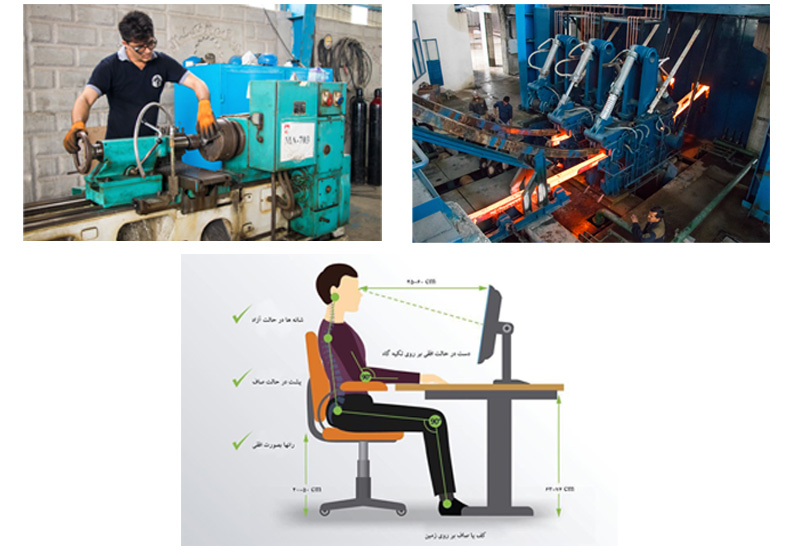
Conveninent Work Environment
Occupational Safety and Health Parameters for Appropriate and Safe Workplace :
From the beginning of industrial revolution and the transition from small workshops to mass-produced factories, and as a result of enormous costs of insecure environments, the issue of protecting the health of the workforce became more individualized and general. In addition to financial issues, there are other important reasons to consider safety. The costs of pain, fatigue, exhaustion and worries of the employees cannot be easily expressed in terms of financial figures. But the only thing that can help reduce accidents is to observing safety principles. These principles, of course, must be implemented under specific terms and conditions.
Safety:
ISO 8402 defines the term safety as follows:
"It is a situation where the risk of harm to persons or property is substantially limited."
There is also another definition in the ISO / IEC standard: "Safety is an unacceptable risk".
Occupational Health and Safety:
Conditions that affect the health of employees, temporary workers, the contractors, guests, and anyone present in the workplace.
OH&S Management System:
It is part of the entire management system that encompasses occupational health and safety management and includes planning activities, duties and responsibilities, rules, procedures, and processes related to occupational safety and health.
The structure of occupational health and safety management systems:
The structure of occupational health and safety management systems, as other management systems (such as the quality management system and environmental management system) is based on five general principles:
Principle One: Policy Commitment.
Principle Two: Planning.
Principle Three: Implementation and Operations.
Principle 4: Control and Corrective Action.
Principle Five: Overview and Improvement.
As can be easily deduced, these principles are designed on the basis of the quality improvement of the Deming Cycle known as the PDCA cycle. If we consider principle one as overall objective setting and commitment to the management and staff of the organization, the next four principles are exactly in accordance with the four stages of the demanding cycle namely planning, executing (DO), controlling (CHECK and ACTION).
Purpose of Occupational Health and Safety Management System:
The purpose of the occupational health and safety management system is to ensure that the organization recognizes how its health and safety activities are impacted and develops measures to control and improve it.
These measurements are made through a suitable process that includes:
- Monitor and review functions
- Reforming the discrepancies observed in audits that are periodically reported to the top management of the organization.
Standards:
Due to the overwhelming need for safety management systems, many standards have been developed.
- Occupational Safety and Health Standards:
The purpose of these standards is to minimize the dangers that threaten people in the workplace. The most popular of these standards are:
• BS 8800
• OHSAS18001
• OH&S Australia and New Zealand
OHSAS 18001 Standard:
This standard outlines the requirements of the Occupational Safety and Health Management System (OH&S) so that an organization can control the safety and health risks and improve its performance. The standard text does not reflect the occupational health and safety performance criteria and does not specify the detailed design features of the management system. The standard applies to any organization that wishes to:
A) Applying a Occupational Safety and Health Management System to eliminate or minimize the risk to employees and other people in work place who are exposed to occupational safety and health hazards.
B) Implement and maintain and improve occupational health and safety management system.
C) Ensure compliance with the Occupational Safety and Health Policy.
D) proving conformity to others.
E) Certification / registration of its occupational health and safety management system by the External Organization.
F) Determining and announcing the organization's compliance with OHSAS.
All the requirements of the standard are intended for use in any occupational health and safety management system. Its scope depends on factors such as the organization's occupational safety and health policy, the nature of its activities and risks, and the degree of complexity of activities.
The OHSAS standard focuses on occupational safety and health rather than product and service safety.
Improvement in occupational safety and health management system in Dorfak Shomal Steel Complex has led to improvement in occupational safety and health performance. Implementation of occupational health and safety management system has added value to the activities of this complex and appropriate work environment.
The consequence of the occupational safety and health management system is to create a coherent process for continuous improvement that is determined by the organization in terms of economic and other conditions.
It should be noted that the occupational health and safety management system is a means which the organization can use to achieve the level of occupational safety performance it determines. Therefore, the establishment and deployment of an occupational safety and health management system alone does not necessarily lead to an immediate reduction in occupational safety and health events.
The integration of the occupational health and safety management system with the entire management system in the Dorfak Shomal Steel Complex has facilitated the effective implementation of the occupational safety and health management system and also helped clarify the tasks and avoid redundancies.








